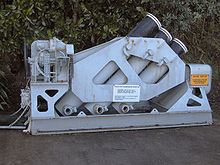| This article relies largely or entirely on a single source. Relevant discussion may be found on the talk page. Please help improve this article by introducing citations to additional sources. Find sources: "Anti-submarine mortar" – news · newspapers · books · scholar · JSTOR (July 2024) |

Anti-submarine mortars are artillery pieces deployed on ships for the purpose of sinking submarines by a direct hit with a small explosive charge. They are often larger versions of the mortar used by infantry and fire a projectile in relatively the same manner. They were created during World War II as a development of the depth charge and work on the same principle.
Beginnings

Anti-submarine warfare did not become an issue of great concern until World War I, when Germany used submarines in an attempt to strangle British shipping in the Atlantic Ocean and elsewhere. The earliest way to counter a submarine was in the form of depth charges, which were large canisters filled with explosives, rolled off the back of a ship and detonated by a hydrostatic fuze. Depth charges served well throughout World War I but were not without flaws. A ship had to pass directly over a submarine to score an effective hit, and as such, depth charges were dropped in lines instead of more effective clusters and could only be carried in ships fast enough to avoid the concussion of the explosion. The depth charges were also not as effective as one might think at sinking a submarine - only a very close detonation would sink a submarine, and the problems of scoring a direct hit meant that a submarine was more often damaged than destroyed by depth charges.
After World War I depth charge throwers were developed, which could hurl depth charges some 100 feet (30 m) from the side of a ship, perpendicular to its direction of travel. These were a significant improvement over the old method, permitting the use of large 'patterns' of up to ten depth charges from the throwers and stern depth charge rails used together. However, they still required a ship to pass very close to a submarine, which entailed a loss of sonar (ASDIC) contact during the final stages of the approach. Submarines could and did use this period to take evasive action.
It was the British who developed the first anti-submarine mortars. Several versions appeared in 1917, most notably the BL 7.5-inch naval howitzer. However, the anti-submarine mortar did not become a truly successful weapon until the advent of the multi-barrelled Hedgehog 25 years later.
World War II anti-submarine mortars

During World War II, submarines once again posed a major threat to Allied shipping, which necessitated the development of more effective anti-submarine mortars. These all had the common characteristic of throwing multiple charges ahead of the attacking vessel while it was still in sonar contact with a submarine. The most successful was the Hedgehog, which consisted of 24 small spigot mortar rounds, each one 7 inches (180 mm) in diameter and weighing 65 pounds (29 kg) with a 35-pound (16 kg) warhead. Each projectile had a range of about 250 yards (230 m) and was fired in a circular pattern in front of a ship. While the warhead on a Hedgehog was much smaller than that of a depth charge, it scored three times as many kills than its predecessors. This was due to the use of a contact fuze on the projectile, which would only detonate on impact with a target. Since the projectile would only explode on a hit, the long periods of sonar "blackout" from the blast and turbulence of a conventional depth charge explosion were eliminated. In the later stages of World War II, the Hedgehog was complemented in British service by the Squid three-barrelled depth charge mortar, which fired 390 lb (180 kg) depth charges to a range of 270 yd (250 m).
Cold war development

The homing torpedo and anti-submarine rocket largely replaced the anti-submarine mortar in naval combat. The British Limbo system, with three gyro-stabilized barrels, fires 350-pound (160 kg) projectiles to a range of 1,000 yards (910 m). It remained in service with many British and Commonwealth navies until the 1980s. The Italian Menon system, introduced in 1956, was used until their retirement in the 1980s. The Elma ASW-600 anti-submarine mortar, developed by Sweden in the 1980s, is the latest weapon of the type and is still in limited use.
List of anti-submarine mortars
Citations
- Campbell, pp. 91–93, 166–167
Bibliography
- Campbell, John (1985). Naval Weapons of World War II. Annapolis, Maryland: Naval Institute Press. ISBN 0-87021-459-4.